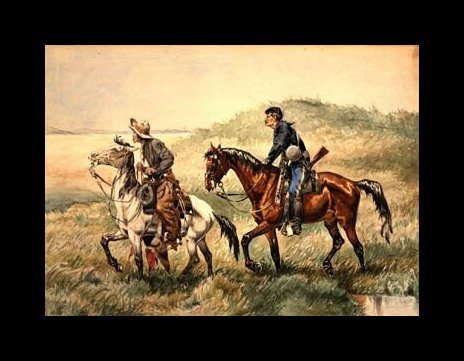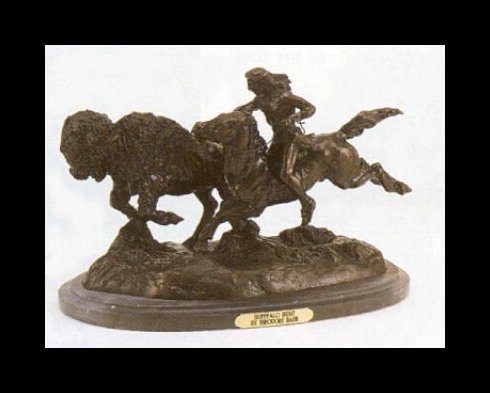Frederick Sackrider Remington (1861-1909)
Get a Remington Certificate of Authenticity for your painting (COA) for your Remington drawing.
For all your Remington artworks you need a Certificate of Authenticity (COA) in order to sell, to insure or to donate for a tax deduction.
Getting a Remington Certificate of Authenticity (COA) is easy. Just send us photos and dimensions and tell us what you know about the origin or history of your Remington painting or drawing.
If you want to sell your Remington painting or drawing use our selling services. We offer Remington selling help, selling advice, private treaty sales and full brokerage.
We have been authenticating Remington and issuing certificates of authenticity since 2002. We are recognized Remington experts and Remington certified appraisers. We issue COAs and appraisals for all Remington artworks.
Our Remington paintings and drawings authentications are accepted and respected worldwide.
Each COA is backed by in-depth research and analysis authentication reports.
The Remington certificates of authenticity we issue are based on solid, reliable and fully referenced art investigations, authentication research, analytical work and forensic studies.
We are available to examine your Remington painting or drawing anywhere in the world.
You will generally receive your certificates of authenticity and authentication report within two weeks. Some complicated cases with difficult to research Remington paintings or drawings take longer.
Our clients include Remington collectors, investors, tax authorities, insurance adjusters, appraisers, valuers, auctioneers, Federal agencies and many law firms.
We perform Frederick Sackrider Remington art authentication, appraisal, certificates of authenticity (COA), analysis, research, scientific tests, full art authentications. We will help you sell your Frederick Sackrider Remington or we will sell it for you.

Frederic Remington (1861-1909) is not usually thought of as a Romantic painter, but in fact Remington’s whole career was devoted to the “Vanishing Wild West”. One of his closest friends was that once-famous retailer of the Circus-Tent Wild West, William Cody, aka “Buffalo Bill”.

Remington, who started life in small-town New York State and ended up in wildest Connecticut, was a frustrated cowboy. Make that sheepboy, because the young Remington was brave enough to take his modest inheritance and buy a sheep ranch in Kansas. He soon thought better of it and hastened back East again. But the West was in his blood, and he developed his talent for drawing by recording scenes of Western life. Remington’s timing was good. The urban east couldn’t get enough of Western exotica. His first crude drawings were redrawn and accepted by Harper’s and Colliers. A career was born, his first of two. He became a sought-after illustrator, rarely straying from his Western theme. Horses and men, men and horses. Men and horses in every conceivable posture. Men meant cowboys, cavalry, Indians and Mexicans. Landscape was nowhere. It was an optimistic, lively, simple art.

During his lifetime, Remington produced some 3,000 paintings and countless sketches, illustrations and quite a few bronzes. Remington’s love for his subjects helped him to create true to life lines, shapes and colors of the still new and wild American west.


Like almost all illustrators of the time, Remington was virtually a photographic journalist, recording what he saw on his brief forays westward. His drawings are accurate, spirited and often carry a narrative message. But things were about to change.
An aficionado of equine adventure, he signed up as a correspondent for the Spanish-American war in 1898, decamping to Cuba. What he saw was not adventure but war, sickening and brutal. Remington managed to miss most of the action and soon tired of the slaughter. He also fell ill. Casualties in pre-20th century wars were typically the result of disease rather than combat. He headed home in some haste to recuperate and repent.
Recuperation of the body could not dispel the psychological effects of war however. Remington, the obese and terminally Eastern artist, had lost his innocence. Henceforth his art ceased to be illustration, morphing into a deliberate effort to portray “The West” as serious art. He had less than a decade to achieve this, as he was to die prematurely at 48 from peritonitis. In that brief time, Remington the Romantic carved a unique niche for himself in the history of American art. Gone were the carefree cowboys. Instead a darker vision of man’s desperate struggle in the wilderness suffused his work. He struggled to shed the two dead weights which limited every Victorian illustrator: monochrome and detail. Color and simplicity were now his life’s work.
Remington succeeded brilliantly. Had he lived, he would have been recognized as a great international artist. As it was, his late work is still a monumental achievement. So much so that in 2003 the National Gallery of Art showed 70 of his “nocturnes”, in which he strives to capture the color of night. Many of these pictures will never be surpassed in their depiction of foreboding and threat in the wilderness.
Still wondering about a paintingin your family collection? Contact us…it could be by Frederick Sackrider Remington.
Reviews
1,217 global ratings
5 Star
4 Star
3 Star
2 Star
1 Star
Your evaluation is very important to us. Thank you.
